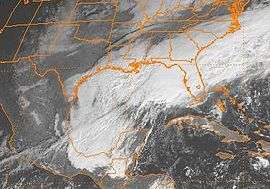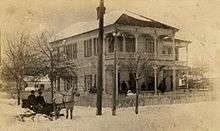Snow in Louisiana

Snow in the state of Louisiana presents a rare and serious problem because of the state's subtropical climate. For snow to push into the southern region of Louisiana, extreme weather conditions for the area must be present, usually a low-pressure system coupled with unusually low temperatures.[1] Average snowfall in Louisiana is approximately 0.2 inches (5.1 mm) per year, a low figure rivaled only by the states of Florida and Hawaii.[2] Due to the infrequency of these cold weather patterns,[3] southern areas affected in this state are often unprepared to deal with slick streets and freezing temperatures.
Notable events

1895: A large snow storm spanning from Texas to Alabama left New Orleans with approximately 8.2 inches (21 cm) of snow, Lake Charles with 22 inches (56 cm) of snow, and Rayne with 24 inches (61 cm) of snow. However, these are unconfirmed.[4]
1899: With the Great Blizzard of 1899, snowfall in New Orleans reached 3.8 inches (9.7 cm) with strong winds and temperatures below 10 °F (−12 °C).[4]
2004: The 2004 Christmas Eve snowstorm swept across southern Texas and Louisiana, leaving unprecedented amounts of snow in areas that had not seen snow in 15 to 120 years.[5]
2008: It snowed in and around semi-tropical New Orleans on Thursday December 11th, 2008.
From dawn to mid-morning a thick snowfall of plump, wet flakes buried much of southeast Louisiana, from Amite to Westwego, under a blanket of white. Snow in inches: Lawrence County, MS: 9.0" Bogue Chitto, MS: 8.0"** Amite, LA: 8.0" Washington, LA: 6.0" Opelousas, LA: 6.0" Covington, LA: 6.0" Hammond, LA: 6.0" Beaumont, TX: 4.0"
2014: The early 2014 North American cold wave that blew through the eastern portion of the continental United States produced record low temperatures and brought freezing snow and sleet to Louisiana.[6]
2017: Early in the morning on December 8, 2017, a winter storm dripped snowflakes on much of south Louisiana. Throughout the day, more and more snow fell. Snow lasted all day long. Heavy snowfall fell on the ground, giving some places a 6-inch snowfall day. Most schools across Louisiana closed due to the snow.
State preparedness
Because of the scarcity of freezing temperatures in Louisiana, many citizens of the region are often left unprepared to handle what might be considered a storm of little consequence in more northern states. The region has developed a system of road and school closures with only minimal snowfall, as most drivers in the area are unprepared to deal with slick, frozen roads.[7][8] In fact, the governor of Louisiana may choose to invoke the Louisiana Homeland Security and Emergency Assistance and Disaster Act, R.S. 29:721, to declare a state of emergency due to extreme cold and snow. In 2014, Gov. Bobby Jindal did just that in advance of the weather and assembled teams to assist in preparation and recovery.[9]
Louisiana's environment
The state's typically humid subtropical climate rarely encounters precipitation coupled with freezing temperatures. The Gulf of Mexico helps maintain this climate, particularly closer to the coast. The normally extreme summers are rarely countered by cold winters, with snowfall low in intensity and frequency.[10] Average winter temperature normals in southern Louisiana vary from the 40s to the 60s Fahrenheit.[3] Natural disasters such as hurricanes are far more common, and such an ecosystem is ill prepared for snow, particularly the seafood supply on which Louisiana relies for much of its revenue.[11] Little research has been done directly linking effects on Louisiana's ecosystem to snow conditions. However, the jet stream that created the 2014 North American cold wave has been linked to global warming,[12] and resultant cold fronts have been linked to salt water intrusion in Louisiana's Atchafalaya Bay.[13] However, one of Louisiana's most famous animals, the alligator, has proved versatile in adapting to cold weather conditions by burrowing in "alligator holes", which they usually use for waiting out a drought.[14] Studies conducted in Finland and Sweden suggest that snow creates more potential problems in urban communities due to increased pollution in runoff.[15][16] Due to the state's lack of resources and funding, however, it is unclear what levels of pollution due to snow affect the Louisiana area.
See also
References
- ↑ Palmer, Chad. "How a low-pressure system affects weather". USA Today. Retrieved 3 March 2014.
- ↑ "U.S. Average Snow State Rank". World Media Group. Retrieved 1 April 2014.
- 1 2 "1981-2010 NCDC Monthly Normals". Southern Regional Climate Center. Retrieved 5 March 2014.
- 1 2 Burt, Christopher (2011). "Snowstorms in the Southeast and Deep South of the United States: An Historical Perspective". Wunderground. Retrieved 4 March 2014.
- ↑ "The Great Christmas Eve Snow Storm". Farmer's Almanac. 2006. Retrieved 5 March 2014.
- ↑ Masters, Jeff (7 January 2014). "Extreme Cold Wave Invades Eastern Half of U.S." Wunderground. Retrieved 5 March 2014.
- ↑ "Baton Rouge area road and interstate closures". The Times Picayune. 29 January 2014. Retrieved 5 March 2014.
- ↑ Rischer, Richard (29 January 2014). "Southeast Louisiana, south Mississippi winter storm". WDSU News. Retrieved 5 March 2014.
- ↑ "Press Release". State of Louisiana. Retrieved 28 March 2014.
- ↑ "Warm, subtropical climate gives an opportunity for year round operations". CLECO Business Development. Retrieved 5 March 2014.
- ↑ Gunn, Billy; Ward Steven (1 February 2014). "Chilly temperatures before Super Bowl weekend cause short supply, higher prices". The Advocate. Retrieved 5 March 2014.
- ↑ Neuman, Scott (16 February 2014). "Warming Arctic May Be Causing Jet Stream To Lose Its Way". NPR. Retrieved 5 March 2014.
- ↑ Li, Chunyan; Roberts, Harry; Stone, Gregory; Weeks, Eddie; Yixin, Luo (January 2011). "Wind surge and saltwater intrusion in Atchafalaya Bay during onshore winds prior to cold front passage". Hydrobiologia. 658 (1): 27–39. doi:10.1007/s10750-010-0467-5. ISSN 0018-8158. Retrieved 5 March 2014.
- ↑ Thomas, Bob. "Where Do Alligators Go in Winter?". Loyola University New Orleans. Retrieved 1 April 2014.
- ↑ Sillanpaa, Nora (2013). "Catchment-scale evaluation of pollution potential of urban snow at two residential catchments in southern Finland". Water Science and Technology. 68 (10): 2164–2170. doi:10.2166/wst.2013.466. Retrieved 5 March 2014.
- ↑ Lundberg, Angela; Feiccabrino, James; Westerlund, Camilla; Al-Ansari, Nadhir (2014). "Urban snow deposits versus snow cooling plants in northern Sweden: a quantitative analysis of snow melt pollutant releases". Water Quality Research Journal of Canada. 49 (1): 32–42. doi:10.2166/wqrjc.2013.042.
External links
| Wikimedia Commons has media related to Snow in Louisiana. |
- Louisiana Office of State Climatology. losc.lsu.edu
- United Nations Environment Programme unep.org